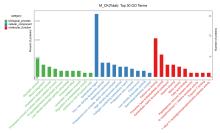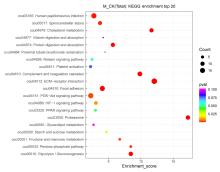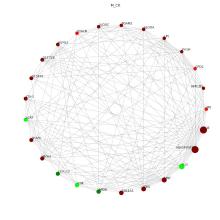| 1 |
GUTIÉRREZ J M, WILLIAMS D, FAN H W, et al. Snakebite envenoming from a global perspective: towards an integrated approach[J]. Toxicon, 2010, 56(7): 1223-1235.
|
| 2 |
BROECKHOVEN C, DU PLESSIS A. Has snake Fang evolution lost its bite? New insights from a structural mechanics viewpoint[J]. Biol Lett, 2017, 13(8): 20170293.
|
| 3 |
何忠杰, 任国军, 张 宪, 等. 北方城市蛇伤的网络防治调查[J]. 中国全科医学, 2007, 10(17): 1453-1455.
|
| 4 |
TRISHNANANDA M. Incidence, clinical manifestation and general management of snake bites[J]. Southeast Asian J Trop Med Public Health, 1979, 10(2): 248-250.
|
| 5 |
Watanabe S, Scheich H, Braun K, et al. Visual snake aversion in Octodon degus and C57BL/6 mice[J]. Anim Cogn, 2022,25(1):33-41.
|
| 6 |
YAP M K K, TAN N H, SIM S M, et al. Pharmacokinetics of Naja sumatrana (equatorial spitting cobra) venom and its major toxins in experimentally envenomed rabbits[J].PLoS Negl Trop Dis, 2014, 8(6): e2890.
|
| 7 |
PALM N W, MEDZHITOV R. Role of the inflammasome in defense against venoms[J]. PNAS, 2013, 110(5): 1809-1814.
|
| 8 |
CALVETE J J. Proteomic tools against the neglected pathology of snake bite envenoming[J]. Expert Rev Proteomics, 2011, 8(6): 739-758.
|
| 9 |
MALIH I, AHMAD RUSMILI M R, TEE T Y, et al. Proteomic analysis of Moroccan cobra Naja haje legionis venom using tandem mass spectrometry[J]. J Proteom, 2014, 96: 240-252.
|
| 10 |
CHANG H C, TSAI T S, TSAI I H. Functional proteomic approach to discover geographic variations of king cobra venoms from Southeast Asia and China[J]. J Proteomics, 2013, 89: 141-153.
|
| 11 |
GUTIÉRREZ J M, ESCALANTE T, RUCAVADO A, et al. A comprehensive view of the structural and functional alterations of extracellular matrix by snake venom metalloproteinases (SVMPs):novel perspectives on the pathophysiology of envenoming[J].Toxins, 2016, 8(10): 304.
|
| 12 |
GOLAGHAEI A, HASSANIAN-MOGHADDAM H, SHADNIA S, et al. Potential prognostic roles of serum lactate and Creatine kinase levels in poisoned patients[J]. BMC Emerg Med, 2020, 20(1): 32.
|
| 13 |
PAJOUM A, FAHIM F, AKHLAGHDOUST M,et al. Rhabdomyolysis and acute poisoning; a brief report[J]. Emerg (Tehran), 2018, 6(1): e56.
|
| 14 |
WU F, BEARD D A. Roles of the creatine kinase system and myoglobin in maintaining energetic state in the working heart[J]. BMC Syst Biol, 2009, 3: 22.
|
| 15 |
GARCÍA BOSSI J, KUMAR K, BARBERINI M L, et al. The role of P-type ⅡA and P-type IIB Ca2+-ATPases in plant development and growth[J]. J Exp Bot, 2020, 71(4): 1239-1248.
|
| 16 |
KHODABUKUS A, KAZA A, WANG J, et al. Tissue-engineered human myobundle system as a platform for evaluation of skeletal muscle injury biomarkers[J]. Toxicol Sci, 2020, 176(1): 124-136.
|
| 17 |
JOSHI M, EAGAN J, DESAI N K, et al. A compound heterozygous mutation in GPD1 causes hepatomegaly, steatohepatitis, and hypertriglyceridemia[J]. Eur J Hum Genet, 2014, 22(10): 1229-1232.
|
| 18 |
LIN H H, TSAI W C, TSAI C K, et al. Overexpression of cell-surface marker SLC16A1 shortened survival in human high-grade gliomas[J]. J Mol Neurosci, 2021, 71(8): 1614-1621.
|
| 19 |
FURUHASHI M, SAKUMA I, MORIMOTO T, et al. Independent and distinct associations of FABP4 and FABP5 with metabolic parameters in type 2 diabetes mellitus[J]. Front Endocrinol (Lausanne), 2020, 11: 575557.
|
| 20 |
HAAS R, SMITH J, ROCHER-ROS V, et al. Lactate regulates metabolic and pro-inflammatory circuits in control of T cell migration and effector functions[J]. PLoS Biol, 2015, 13(7): e1002202.
|
| 21 |
SHEN H Y, WEI F Z, LIU Q. Differential analysis revealing APOC1 to be a diagnostic and prognostic marker for liver metastases of colorectal cancer[J]. World J Clin Cases, 2021, 9(16): 3880-3894.
|
| 22 |
ZHU X, YI K, HOU D, et al. Clinicopathological analysis and prognostic assessment of transcobalamin Ⅰ(TCN1) in patients with colorectal tumors[J]. Med Sci Monit, 2020, 26: e923828.
|
| 23 |
JABOR A, VACKOVÁ T, KUBÍČEK Z, et al. Biological variation of proprotein convertase subtilisin/kexin type 9 (PCSK9) in human serum[J]. Clin Chimica Acta, 2021, 521: 59-63.
|
| 24 |
DUDEK-PERIĆ A M, FERREIRA G B, MUCHOWICZ A, et al. Antitumor immunity triggered by melphalan is potentiated by melanoma cell surface–associated calreticulin[J]. Cancer Res, 2015, 75(8): 1603-1614.
|
 ),沈芳华1,张勇1,陈福伟1,苏秋香2,史超2,余沁瑶2,陈涛2
),沈芳华1,张勇1,陈福伟1,苏秋香2,史超2,余沁瑶2,陈涛2
 ),Fanghua SHEN1,Yong ZHANG1,Fuwei CHEN1,Qiuxiang SU2,Chao SHI2,Qinyao YU2,Tao CHEN2
),Fanghua SHEN1,Yong ZHANG1,Fuwei CHEN1,Qiuxiang SU2,Chao SHI2,Qinyao YU2,Tao CHEN2










